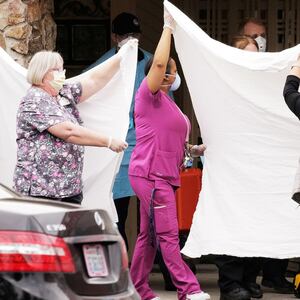The revelation on Tuesday of two new deaths tied to the 2019 novel coronavirus, including a man who died six days ago in Washington state, bolstered fears that the infection had been spreading inside the United States before authorities were fully aware.
There were at least 108 novel coronavirus cases in the U.S. as of Tuesday afternoon, with 60 picked up through the American health system, according to the Centers for Disease Control and Prevention (CDC). About 22 of those were travel-related, 11 were community spread, or of unknown origin, and the rest were still under investigation. Another 48 cases were in quarantined patients from the Diamond Princess cruise ship off Japan or individuals who had been repatriated from the virus’ epicenter in China, according to the CDC.
Both Florida and Washington declared public health emergencies over the outbreak on Monday, as did Bexar County, Texas, where a quarantined patient was prematurely released in San Antonio before a third test came back positive for the virus.
ADVERTISEMENT
Nine deaths have been reported in Washington state since Saturday, eight of which were in King County, with another in Snohomish County, officials said.
Health experts have repeatedly warned that nursing homes and other assisted living facilities are especially vulnerable because of their confined spaces and elderly residents. Many of the residents have underlying health conditions that make them more likely to contract not just the coronavirus, but a severe infection.
As those experts predicted, the most concerning outbreak on American soil has erupted at Life Care Center, a Kirkland, Washington long-term care facility connected to most of the King County deaths. Health authorities in Washington have said about 50 residents and staff members have exhibited symptoms and will be monitored or tested. Of the 27 total cases in Washington state, at least nine have been linked to Life Care, The Seattle Times reported. Four patients in the Seattle area remained in critical condition on Tuesday, officials said.
“This is a very fluid, fast-moving situation as we aggressively respond to this outbreak,” said a statement from Dr. Jeff Duchin, the health officer for Public Health–Seattle & King County.
A physician who attended patients at Life Care Center, who requested anonymity for fear of professional repercussions, told The Daily Beast on Tuesday that he was at the facility on Thursday, when the outbreak began to reveal itself.
“It started to become evident” on Thursday of last week, he said, when “a bunch of patients” developed fevers.
“It was like a bolt out of the blue,” the physician added.
A genetic analysis of the virus’ spread in Washington suggests that it may have been transmitted within the community for as long as six weeks before the first case was detected. That analysis looked all the more valid on Tuesday when authorities announced a new death that actually happened six days ago. Officials only realized after the fact that the patient, a resident of Life Care, had contracted the coronavirus. The individual was first brought to Harborview Medical Center in Seattle on Feb. 24, where they died on Wednesday. Test samples came back positive for the 2019 novel coronavirus on Tuesday, and a spokeswoman for the hospital, Susan Gregg, has said that “some staff may have been exposed while working in an intensive care unit where the patient had been treated.”
Even with all of the warnings, the doctor who worked at Life Care told The Daily Beast on Tuesday that “nobody was expecting that there’d be this huge outbreak in the facility.”
“I’m there seeing a new patient on Thursday morning,” he explained. “I notice all these nurses coming down the hall, one after the other saying, ‘Fever in this room.’ By about the sixth patient, we all said, ‘Holy shit, what’s going on?’”
He said it was when those feverish patients tested negative for influenza that he got “this feeling in the back of my mind—this was not ordinary, this was something unusual.”
Ellie Basham, the center’s executive director, said in a press release on Monday that there were “several confirmed cases” of the virus and that the facility was expressly following all recommendations from the CDC and the state health department, in addition to banning family, volunteer, and vendor visits to the facility.
“Current residents and associates continue to be monitored closely, specifically for an elevated temperature, cough, and/or shortness of breath. Any resident displaying these symptoms is placed in isolation,” said Basham. “Associates are screened prior to beginning work and upon leaving. We are also following infection control recommendations, including proper hand-washing techniques and wearing masks, gowns, and gloves when caring for any symptomatic patients.”
Since worried family members have been banned from visiting their relatives, they’ve stood outside the windows, holding signs for moral support, said the doctor who worked there.
“It’s heart-rending,” he added. “This is community outbreak. It’s completely a shift in the paradigm and nobody was prepared for looking it from that perspective.”
Dr. Nancy Messonnier, director of the National Center for Immunization and Respiratory Diseases at the CDC, said on Tuesday that new cases in the U.S. span 12 states, including those on the east coast like Florida, Georgia, New Hampshire, Rhode Island, and New York.
New York Gov. Andrew Cuomo announced on Tuesday that a second New York resident—a man in his 50s who lives in Westchester County, works in Manhattan, and had recently traveled to Miami-Dade—had contracted the illness, most likely through “community spread.” Two New York City high schools also announced on Tuesday that they would be closed as precautionary measures after a suspected case of the virus in the community. The first case, which Cuomo announced on Monday, involved a 39-year-old woman in Manhattan who had recently visited Iran and self-isolated before she even developed symptoms over fear that she might be sick.
Messonnier also confirmed on Tuesday that the agency had removed a tally on its website of how many people in the country had been tested or were suspected to have the virus, a move that has been criticized by citizens and politicians alike over the past 24 hours. The CDC’s site, as of Tuesday, only displayed the number of confirmed cases.
Messonnier told reporters during Tuesday’s telebriefing that a study out of China indicates that only about 16 percent of cases result in serious illness, a statistic she said should reassure communities who are worried about infection or death.
“With the global increase in cases and the spread here in the United States, there have been a lot of questions about what might happen to us,” she added. “I wish I could give you that answer. Unfortunately, I cannot.”
“Individual actions can have an important impact,” she said.







